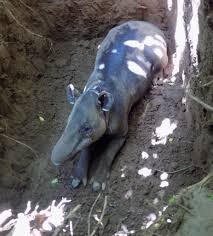Baird's tapir
(Tapirella bairdii)

Description
The Baird's tapir (Tapirus bairdii), also known as the Central American tapir, is a species of tapir native to Mexico, Central America, and northwestern South America. It is the largest of the three species of tapir native to the Americas, as well as the largest native land mammal in both Central and South America. The Baird's tapir is found in many diverse vegetation types. They can withstand elevations from sea level to up to 3600 meters. The animal can be found in wet areas like mangrove forests, marshes, swamp areas, wet tropical rainforests. It also resides in drier areas like riparian woodlands, deciduous forests, and mountainous cloud forests. It prefers secondary growth forests, when available, due to increase in understory plants for foraging and protection. Food and water availability as well as protection are key factors in habitat selection. The Baird's tapir has a distinctive cream-colored marking on its face, throat, and tips of its ears, with a dark spot on each cheek, behind and below the eye. The rest of its bristly hair is dark brown or grayish brown. The animal is very muscly, and about the size of a small donkey. A long thin mane is present but not always conspicuous. It has two small oval shaped eyes flush with the side of the head. Its ears are large, oval-shaped and not very mobile. Baird's tapirs average 2 m (6.6 ft) in length, but can range between 1.8 and 2.5 m (5.9 and 8.2 ft), not counting a stubby, vestigial tail of 5–13 cm (2.0–5.1 in), and 73–120 cm (2.40–3.94 ft) in height. Body mass in adults can range from 150 to 300 kilograms (330 to 660 lb). Like the other species of tapirs, they have small, stubby tails. Their snout and upper lips project forward to create a fleshy and flexible proboscis. This proboscis is their strongest sense organ that aids in finding food and detecting physical stimuli. Their legs are short and slender; well adapted to rapid movement through underbrush. They have four toes on each front foot, and three toes on each back foot.
Taxonomic tree:







